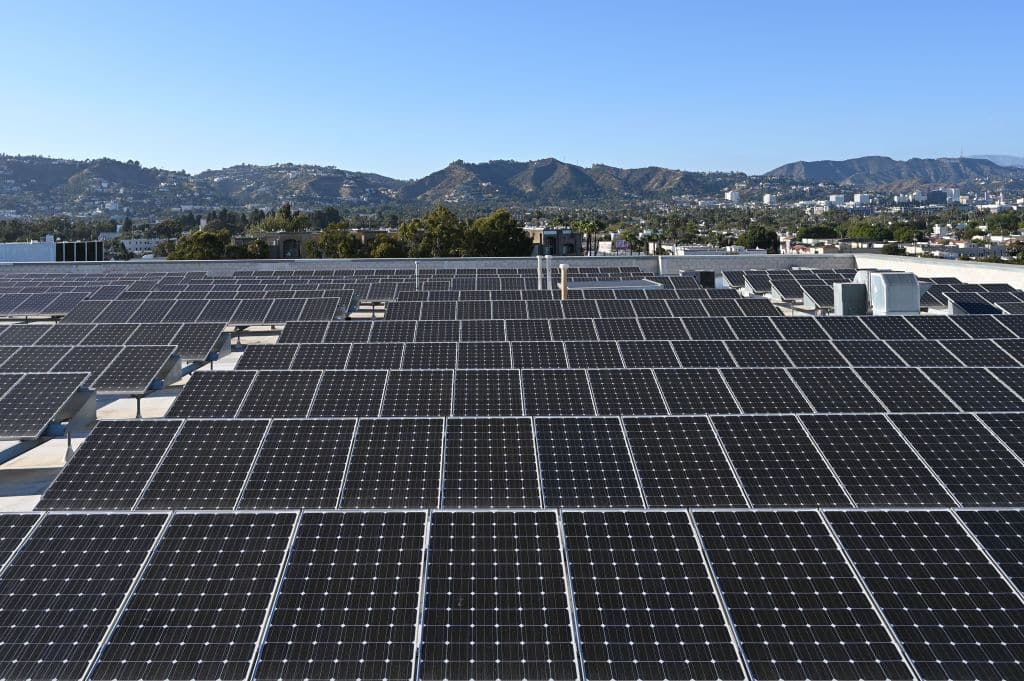Products You May Like
Solar panels are seen on the roof of a building in Los Angeles, California, on June 18 2022. Daniel SLIM / AFP / Getty Images

Why you can trust us
Founded in 2005 as an Ohio-based environmental newspaper, EcoWatch is a digital platform dedicated to publishing quality, science-based content on environmental issues, causes, and solutions.
2022 has been a good year for renewable energy in the U.S. so far.
During its first nine months, renewable sources generated nearly a quarter of the nation’s electricity mix, according to figures from the U.S. Energy Information Administration (EIA) reviewed by the SUN DAY Campaign, overtaking both coal and nuclear.
“Taken together, during the first three-quarters of 2022, renewable energy sources comfortably out-produced both coal and nuclear power by 15.52% and 28.25% respectively,” SUN DAY Campaign Executive Director Ken Bossong wrote for Energy Central. “In fact, over the past half-decade, the mix of renewables has moved from fourth into second place among electrical generating sources while relegating coal and nuclear to third and fourth place.”
The analysis was based on EIA’s “Electric Power Monthly” report, with figures through September 30 published the day before Thanksgiving. It revealed that the total mix of renewable energy sources–which includes wind, utility-and small-scale solar, hydropower, geothermal and biomass–generated 22.66 percent of the nation’s electricity through the first nine months of 2022. This was up from 20.33 percent for the first nine months of 2021.
More From EcoWatch
Overall, renewable sources had increased their performance by 15.44 percent compared to the year before. The analysis also offered a breakdown by power source:
- Wind increased by 18.64 percent, generating nearly 10 percent of all electricity.
- Solar increased by 25.68 percent and accounted for 5.01 percent of the total electricity mix.
- Hydroelectric power increased by 7.98 percent and made up 6.29 percent of the total.
- Geothermal grew by 6.95 percent.
- Biomass decreased by 1.12 percent.
The findings come after the EIA’s Short Term Energy Outlook predicted that renewable energy would generate 22 percent of electricity through the end of 2022 and 24 percent in 2023, mostly because of an increase in wind and solar capacity.
Bossong said the September data suggested that renewable output could fall to at or below that prediction by the end of the year, because wind, hydropower and wind generation all decreased relative to September of 2021, and renewable output for this September was only up by 1.45 percent compared with the same month last year.
“For some time now, EIA has been forecasting renewables to provide 22% of U.S. electrical generation in 2022 – up from 20% a year earlier,” Bossong said. “While they presently are ahead of that level, a slowdown in generation by wind and hydropower during the last quarter of this year could result in renewables falling short of that mark while still exceeding their 2021 record output.”
If they do hit the 22 percent prediction, that will be more than the 20 percent predicted for coal and the 19 percent predicted for nuclear, according to E&E News. The last time renewables beat coal in the U.S. was in 2020, which was an unusual year because of the decrease in demand due to the coronavirus lockdowns.
There is hope now from renewable energy experts that the investments from the Inflation Reduction Act (IRA) will continue to boost capacity going forward.
“The important thing is it continues to grow and we get more capacity installed and output from renewables,” Tufts University economics professor Steve Cicala told E&E News. “The reason that is important is it will mean less generation from fossil resources.”
Subscribe to get exclusive updates in our daily newsletter!
By signing up, you agree to the Terms of Use and Privacy Policy & to receive electronic communications from EcoWatch Media Group, which may include marketing promotions, advertisements and sponsored content.
